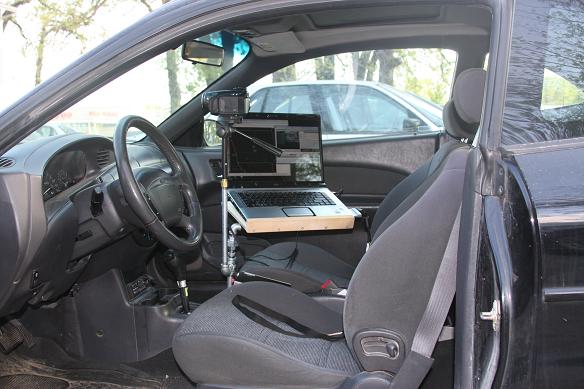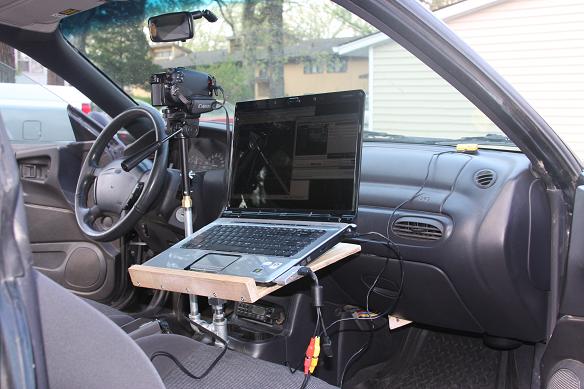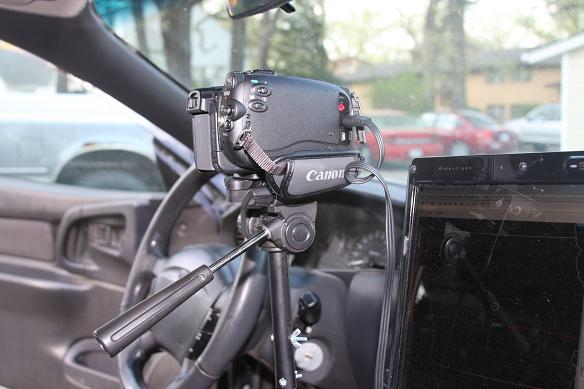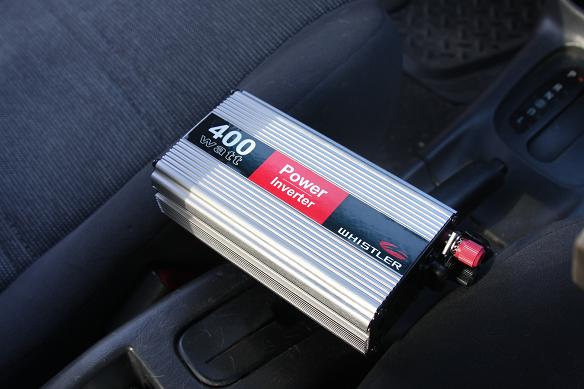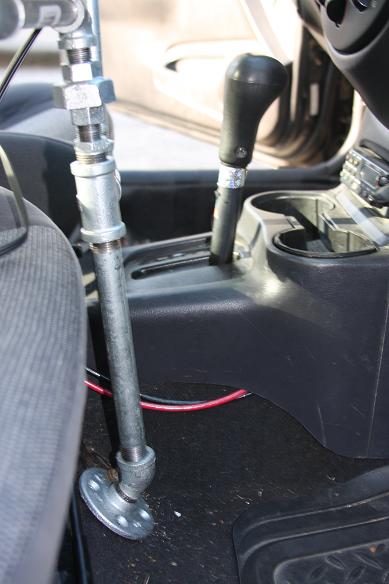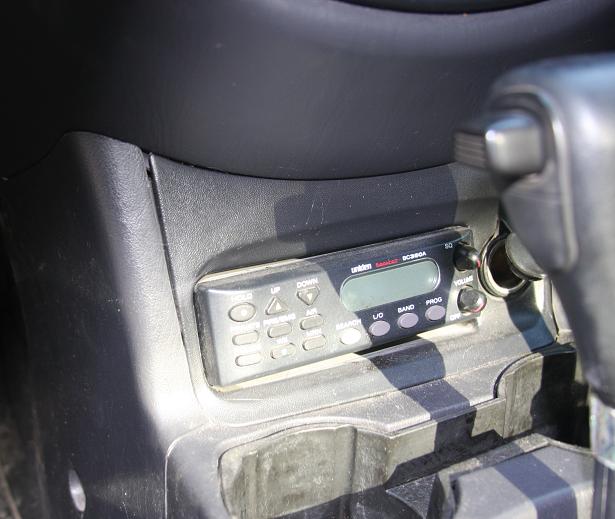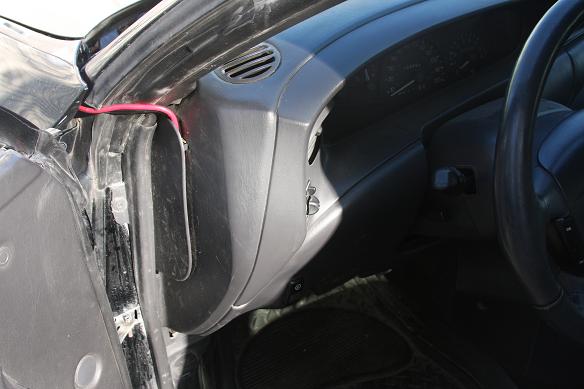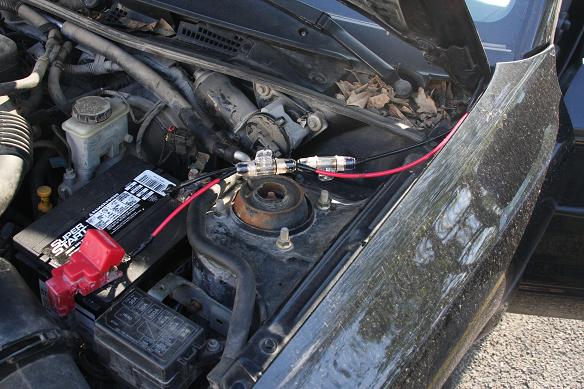Equipment:
During the past 3 years, I've gradually invested in electronic equipment to help me forecast and capture severe weather. So I figure I should share how all my stuff works.
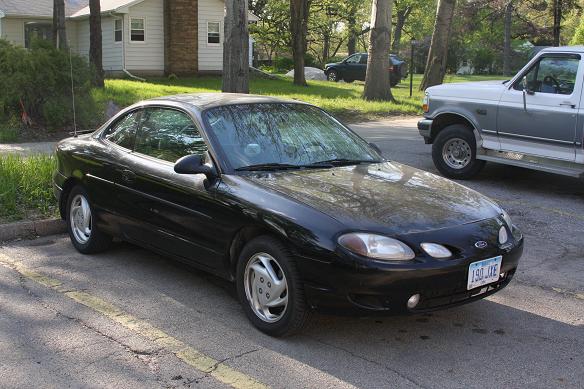
Vehicle: 1999 Ford ZX2Laptop: HP DV6000 with Vista :( Power Inverter: Whistler 400 Watts Camcorder: Canon Vixia HV-30 Camera: Canon 40D GPS: Earthmate LT-20 Software: GRLevel 2, 3, and Analyst, Street Atlas 2008, Delorme Serial Emulator, Spotter Network, Adobe Master Collection CS3 Other: Laptop Mount, TV Tuner, Video Transmitter, Scanner |
Details:
It all starts with the vehicle. I currently drive a black, 1999 Ford ZX2. Going down the road, this 4 cylinder car can manage about 33 mpg. With gas prices they way they are currently, this is a very nice feature to have. However, the car is nearly a decade old, and has just over 100,000 miles. I'll be upgrading to a Ford Fushion in the near future.Inside the car is where the fun begins. To manage the electrical equipment, I have a home-made laptop/camera mount, which is bolted to the front seat of the car. The laptop portion rests on a rotating arm, which locks into position. Branching off the side, I've merged an old tripod mount to the piping. This is where my camcorder will rest a majority of the time. The camcorder I'm using is the Canon HV-30. This is an High-Definition camdorder, which records on Mini-DV tapes. I chose this camcorder because of its excellent low-light performance, ability to record video on the mount while driving (Mini-DV tapes), and the prices was right. For taking still photographs, I have the Canon 40D. I still have a lot to learn about this camera, but I'm absolutely amazed at it's performance and picture quality. It takes very professional looking picures. To power the electronics, I have a 400 watt Whistler power inverter. To supply current to the inverter, I run two, hot and ground, 8-gauge wires from the battery to the inverter. Both 8-gauge wires have in-line fuses, next to the battery. To be safe, I have 20 amp fuses in the fuse-holders. Thanks to Dave Flory and the Stormtrack Equipment forum for helping me set this up. The think-tank of the operation is my HP DV6000 laptop, running Windows Vista. Vista is nothing but a pain, as I've run into a number of incompatiblity issues with the software. I've magaged to work my way around most of these issues though. I'll have both my camcorder and my phone connected to the laptop. This is so I can connect to the internet on the road for data, and stream video to my website. At the present time, I have Alltel with tethering enabled for internet on the road. Alltel was my preferred choice, since they offer unlimited data transfer at a cheap price. The HP TV Tuner fits directly into the built-in express card slot on the laptop. This tuner has a port where I can connect a component video source. To make use of this feature, I take the "Video Out" from the camcorder and connect it to the tuner. This allows me to simultaneously record video on the camcorder and the computer, and to upload video-caps to the web. To upload the video-caps, I currently use EysSpyFX, a free webcam software. My browser of choice is Mozilla Firefox. To analyze data, Scott Lincoln and I have created a chase page for low-bandwidth users. This page offers links to Just the .gifs, .jpgs, etc. on our favorite weather sites. For analyzing data on a highly variable cellular internet connection, where time is everything, this is a nice feature to have. To view radar, I use GRLevel3, with GPS support. The GPS receiver I'm using is the Earthmate LT-20, which came with Street Atlas 2008. To make use of my GPS in other software, I use the Delorme Serial Emulator. This had some issues with Vista, so I had to install a different driver to get the emulator to work. With that up and running, I can load my GPS position into GRLevel3 and Spotternetwork . The sofware updates my GPS position to a placefile which can be viewed in the Gibson-Ridge radar software. If nothing else, I have a Scanner wired in so I can listen in to the weather radio, as well as emergency management personel. When the show is over, I use Abobe Premiere Pro CS3 to edit video and Photoshop on the pictures. To connect the camcorder and computer, I use a 4-pin to 4-pin firewire cable. Finally, if I'm with a group of chasers who want to have internet, but don't have the means of aquiring it, I've come up with a solution that requires the other vehicle to have a small TV or TV tuner. The plan is to connect my "S-Video Out" from my computer to a small TV Transmitter. This transmitter will broadcast my computer screen in a ~500 ft. UHF radious. So, if the other vehicles have an antenna for their tv device, they can pick up the signal and view my screen while going down the road. The only hickup in this process is tricking windows into thinking that I'm connected to an external monitor, rather than the tranmitter. Without the trick, windows will not output the video through the S-Video port. To complete the trick, a small wire must be connected from pin-hole 1 to pin-hole 3. That way, when you press the button to connect to an external monitor, windows will receive the signal back. |
Feel free to contact me at: karstens.chris@gmail.com
Updated 12 May 2008
Updated 12 May 2008

